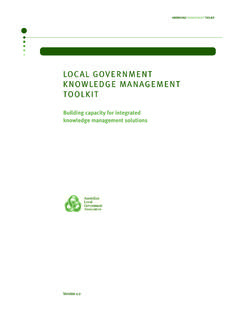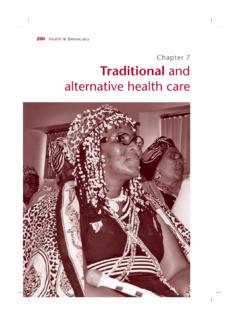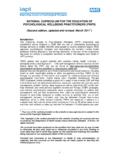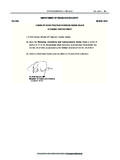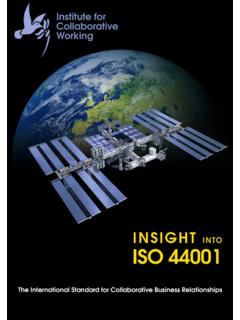Transcription of Chapter 11 knowledge especially natural sciences were ...
1 Ever since the days of Rene Descartes, the French philosopher,mathematician and biologist of seventeenth century, all humanknowledge especially natural sciences were directed to developtechnologies which add to the creature comforts of humanlives, as also value to human life. The whole approach tounderstanding natural phenomena became and chemistry gave rise to engineering, technologiesand industries which all worked for human comfort and major utility of the biological world is as a source of , the twentieth century off-shoot of modernbiology, changed our daily life as its products broughtqualitative improvement in health and food production. Thebasic principles underlying biotechnological processes and someapplications are highlighted and discussed in this 11 Biotechnology : Principles andProcessesChapter 12 Biotechnology and ItsApplications2015-16 Herbert Boyer was born in 1936 and brought up in a corner of westernPennsylvania where railroads and mines were the destiny of most youngmen.
2 He completed graduate work at the University of Pittsburgh, in1963, followed by three years of post-graduate studies at 1966, Boyer took over assistant professorship at the University ofCalifornia at San Francisco. By 1969, he performed studies on a coupleof restriction enzymes of the E. coli bacterium with especially usefulproperties. Boyer observed that these enzymes have the capability ofcutting DNA strands in a particular fashion, which left what has becameknown as sticky ends on the strands. These clipped ends made pastingtogether pieces of DNA a precise discovery, in turn, led to a rich and rewarding conversation inHawaii with a Stanford scientist named Stanley Cohen.
3 Cohen hadbeen studying small ringlets of DNA called plasmids and which floatabout freely in the cytoplasm of certain bacterial cells and replicateindependently from the coding strand of DNA. Cohen had developeda method of removing these plasmids from the cell and then reinsertingthem in other cells. Combining this process with that of DNA splicingenabled Boyer and Cohen to recombine segments of DNA in desiredconfigurations and insert the DNA in bacterial cells, which could thenact as manufacturing plants for specific proteins. This breakthrough wasthe basis upon which the discipline of biotechnology was BOYER(1936 )2015-16 Biotechnology deals with techniques of using liveorganisms or enzymes from organisms to produce productsand processes useful to humans.
4 In this sense, makingcurd, bread or wine, which are all microbe-mediatedprocesses, could also be thought as a form ofbiotechnology. However, it is used in a restricted sensetoday, to refer to such of those processes which usegenetically modified organisms to achieve the same on alarger scale. Further, many other processes/techniques arealso included under biotechnology. For example, in vitrofertilisation leading to a test-tube baby, synthesising agene and using it, developing a DNA vaccine or correctinga defective gene, are all part of European Federation of Biotechnology (EFB) hasgiven a definition of biotechnology that encompasses bothtraditional view and modern molecular definition given by EFB is as follows: The integration of natural science and organisms,cells, parts thereof, and molecular analogues for productsand services.
5 PRINCIPLES OF BIOTECHNOLOGYA mong many, the two core techniques that enabled birthof modern biotechnology are :(i)Genetic engineering : Techniques to alter thechemistry of genetic material (DNA and RNA), Chapter 11 BIOTECHNOLOGY : PRINCIPLESAND of of Recombinant of RecombinantDNA Technology2015-16194 BIOLOGYto introduce these into host organisms and thus change thephenotype of the host organism.(ii)Maintenance of sterile (microbial contamination-free) ambiencein chemical engineering processes to enable growth of only thedesired microbe/eukaryotic cell in large quantities for themanufacture of biotechnological products like antibiotics,vaccines, enzymes, us now understand the conceptual development of the principlesof genetic probably appreciate the advantages of sexual reproduction overasexual reproduction.
6 The former provides opportunities for variationsand formulation of unique combinations of genetic setup, some of whichmay be beneficial to the organism as well as the population. Asexualreproduction preserves the genetic information, while sexual reproductionpermits variation. Traditional hybridisation procedures used in plant andanimal breeding, very often lead to inclusion and multiplication ofundesirable genes along with the desired genes. The techniques of geneticengineering which include creation of recombinant DNA, use ofgene cloning and gene transfer, overcome this limitation and allows usto isolate and introduce only one or a set of desirable genes withoutintroducing undesirable genes into the target you know the likely fate of a piece of DNA, which is somehowtransferred into an alien organism?
7 Most likely, this piece of DNA wouldnot be able to multiply itself in the progeny cells of the organism. But,when it gets integrated into the genome of the recipient, it may multiplyand be inherited along with the host DNA. This is because the alien pieceof DNA has become part of a chromosome, which has the ability toreplicate. In a chromosome there is a specific DNA sequence called theorigin of replication, which is responsible for initiating , for the multiplication of any alien piece of DNA in an organismit needs to be a part of a chromosome(s) which has a specific sequenceknown as origin of replication . Thus, an alien DNA is linked with theorigin of replication, so that, this alien piece of DNA can replicate andmultiply itself in the host organism.
8 This can also be called as cloning ormaking multiple identical copies of any template us now focus on the first instance of the construction of an artificialrecombinant DNA molecule. The construction of the first recombinantDNA emerged from the possibility of linking a gene encoding antibioticresistance with a native plasmid (autonomously replicating circularextra-chromosomal DNA) of Salmonella typhimurium. Stanley Cohen andHerbert Boyer accomplished this in 1972 by isolating the antibioticresistance gene by cutting out a piece of DNA from a plasmid which wasresponsible for conferring antibiotic resistance. The cutting of DNA atspecific locations became possible with the discovery of the so-called2015-16 BIOTECHNOLOGY : PRINCIPLES AND PROCESSES195 molecular scissors restriction enzymes.
9 The cut piece of DNA wasthen linked with the plasmid DNA. These plasmid DNA act as vectors totransfer the piece of DNA attached to it. You probably know that mosquitoacts as an insect vector to transfer the malarial parasite into human the same way, a plasmid can be used as vector to deliver an alien pieceof DNA into the host organism. The linking of antibiotic resistance genewith the plasmid vector became possible with the enzyme DNA ligase,which acts on cut DNA molecules and joins their ends. This makes a newcombination of circular autonomously replicating DNA created in vitroand is known as recombinant DNA. When this DNA is transferred intoEscherichia coli, a bacterium closely related to Salmonella, it couldreplicate using the new host s DNA polymerase enzyme and make multiplecopies.
10 The ability to multiply copies of antibiotic resistance gene inE. coli was called cloning of antibiotic resistance gene in E. can hence infer that there are three basic steps in geneticallymodifying an organism (i)identification of DNA with desirable genes;(ii)introduction of the identified DNA into the host;(iii)maintenance of introduced DNA in the host and transfer of the DNAto its OF RECOMBINANT DNA TECHNOLOGYNow we know from the foregoing discussion that genetic engineering orrecombinant DNA technology can be accomplished only if we have thekey tools, , restriction enzymes, polymerase enzymes, ligases, vectorsand the host organism. Let us try to understand some of these in Restriction EnzymesIn the year 1963, the two enzymes responsible for restricting the growthof bacteriophage in Escherichia coli were isolated.










